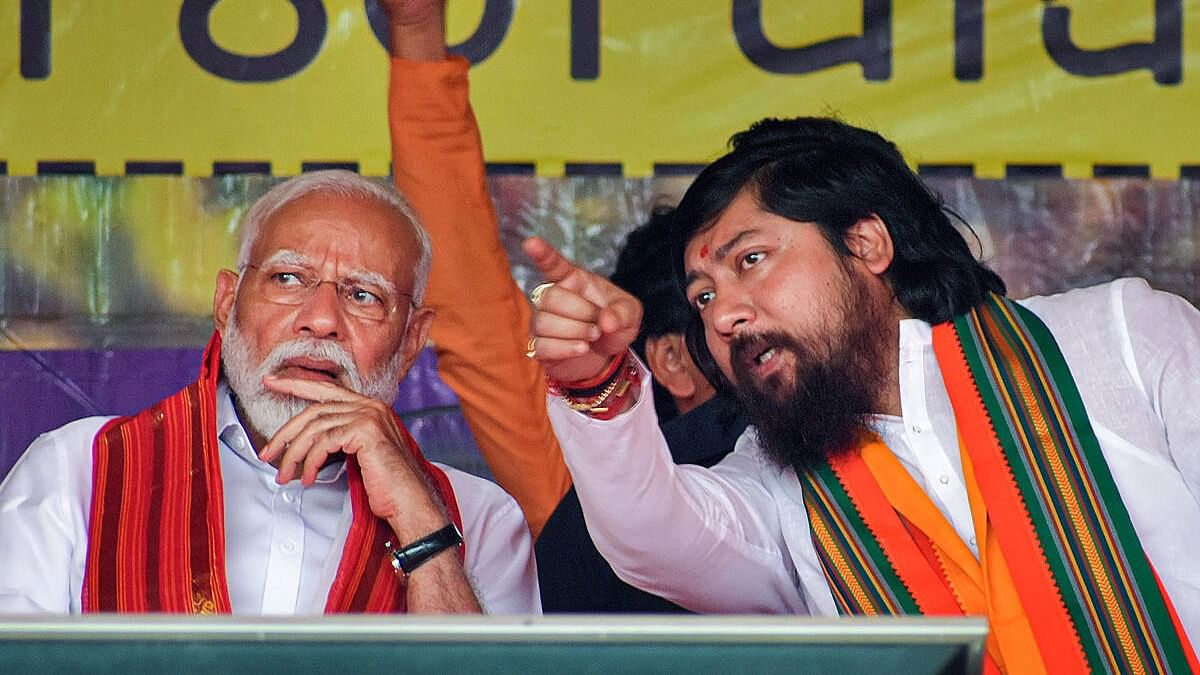
Prime Minister Narendra Modi with Union Minister and BJP candidate Nisith Pramanik during an election campaign rally ahead of the upcoming Lok Sabha polls, in Cooch Behar district, Thursday, April 4, 2024.
Credit: PTI Photo
Over the past few years, the worship of Ram has become a high-profile event in West Bengal’s calendar of religious festivals. That’s not necessarily a development that should occasion comment, but the manner in which Ram Navami has been shoehorned into West Bengal, and the motivation, is cause for concern.
Many religious observances have been increasingly adopted in West Bengal of late — the worship of Ganesh and Hanuman, for instance. But they appear to be part of a larger process of standardisation of Hindu religious practice across India, generally speaking. It’s quite possible that Durga Puja, so quintessentially Bengali, has travelled well to northern India. These developments may deserve sociological enquiry, but they are not per se important in the field of political analysis.
It is, however, quite evident that the promotion of Ram Navami in West Bengal is not innocently religious. It is one of the main drivers of the Bharatiya Janata Party (BJP)’s political project in West Bengal. Just as the Ram Janambhoomi movement and the barbaric calls for the destruction of the Babri masjid and the construction of a Ram temple in its place — mandir wahin banayenge — powered the BJP’s rise to ascendance in north India and eventually made it the biggest party the country with pretensions of creating a monopoly of power in what it sees as a one-party State, the celebration of Ram Navami in West Bengal is meant to propel the BJP into power in the state.
Ram Navami observances, accompanied by processions bearing weapons, first came into the limelight in 2017, when their provocative and aggressive conduct and the choice of sensitive routes caused riots. Since then, such processions have spawned violence on a regular basis, for instance, 2017-2019, 2021, and 2023. This year, too, aggressive Ram Navami posturing stoked violence in Murshidabad district and elsewhere.
There is little doubt that the aggressive rhetoric and conduct of the BJP, Vishwa Hindu Parishad (VHP), and other Sangh constituents have turned Ram Navami into an annual flashpoint. It doesn’t take a great effort to join the dots: creating communal disturbances to polarise West Bengal’s Hindus and Muslims is the only way the BJP knows to mobilise a constituency behind it.
It fits in with much else. The majoritarian rhetoric spitefully and stridently employed by BJP leaders during the 2021 Assembly elections bears witness to the BJP’s ongoing project. Leader of the Opposition Suvendu Adhikari — then a newly-minted defector — let no opportunity go to remind his followers that there was a ’70:30’ division in West Bengal.
Given that the BJP polled 38.15 per cent of the vote in the 2021 elections and the 40.7 it managed in the 2019 general elections, it is clear that it has succeeded significantly in its project.
The clearest evidence that appealing to ‘Hindu’ voters as Hindus is increasingly being seen to be necessary is the conduct of the ruling Trinamool Congress (TMC) this year, perhaps because Ram Navami was on April 17, with the elections kicking off just two days later. The TMC itself held a large number of Ram Navami processions, but eschewed provocative acts, including carrying swords and other arms. The Calcutta High Court allowed the VHP to march in procession on April 21, but laid down stringent conditions, including not carrying arms.
The point, however, is that the BJP has succeeded in normalising Ram Navami processions with distinctly political functions. The Left has criticised the TMC for indulging in competitive communalism. It is right in one sense. The TMC’s strategy is playing into the BJP’s project in that it is helping to normalise the idea of religion-based political mobilisation. It is also bringing religion into the public space in ways that are novel and disturbing.
The TMC feels that it cannot allow a part of the Hindu vote to be pocketed by the BJP. But it would do better to follow the Congress’ strategy and stick to bread-and-butter issues. It has built considerable goodwill through its welfare initiatives, which it can use to blunt the communal edge of the BJP campaign.
Having said that, religion still does not preponderantly drive electoral calculations in West Bengal. What the BJP doesn’t get is that religion does not shape identity in the same way everywhere. In West Bengal, language and the sense of Bengali exceptionalism play a big role in doing so. The TMC harnesses those cultural forces pretty cleverly.
Suhit K Sen is author of ‘The Paradox of Populism: The Indira Gandhi Years, 1966-1977’
Disclaimer: The views expressed above are the author's own. They do not necessarily reflect the views of DH.